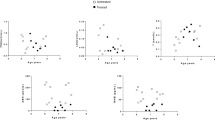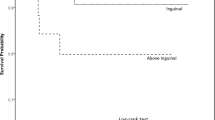Abstract
Purpose
To compare the androgen receptor (AR) status of the appendix testis (AT) in congenital undescended and retractile testes.
Materials and methods
Twenty-four appendix testes (AT) were removed from 21 boys to detect AR expression by immunohistochemistry and immunofluorescence staining. Group 1 (n = 3) includes ATs from three patients with unilateral and group 2 (n = 6) with bilateral congenital undescended testis. All patients with bilateral form had been previously treated with human chorionic gonadotropin (hCG) without an acceptable effect. Group 3 (n = 12) includes ATs collected from 12 boys with acquired undescended testis or retractile testicle. Group 4 (n = 3) includes ATs from three young adults who received hCG treatment for undescended testis in their childhood and underwent open testicular biopsy to investigate infertility. Further seven ATs were collected to detect AR mRNA using RT-PCR analysis.
Results
Both immunohistochemistry and immunofluorescence staining of ATs showed AR expression in 100 % of the cases in groups 3 and 4 (12/12 and 3/3), but there was no visible AR expression in groups 1 and 2 (0/3 and 0/6); however, RT-PCR analysis revealed mRNA expression of AR both in congenital undescended and in retractile testicles.
Conclusions
The presence of AR in the epithelial cells of AT in patients with retractile testicle and its absence in patients with congenital undescended testis can be a possible cause of the effectiveness of hormonal treatment in retractile testis and its inefficacy in patients with congenital undescended testis.



Similar content being viewed by others
References
Atkinson GO Jr, Patrick LE, Ball TI Jr, Stephenson CA, Broecker BH, Woodard JR (2009) The normal and abnormal scrotum in children: evaluation with color Doppler sonography. AJR 158:613–617
Johnson KA, Dewbury KC (1996) Ultrasound imaging of the appendix testis and appendix epididymis. Clin Radiol 51:335–337
Józsa T, Csízy I, Kutasy B, Cserni T, Flaskó T (2008) Decreased incidence of appendix testis in cryptorchidism with intraoperative survey. Urol Int 80:317–320
Sahni D, Jit I, Joshi K, Sanjeev S (1996) Incidence and structure of the appendices of the testis and epididymis. J Anat 189:341–348
Tostes GD, Costa SF, de Carvalho JP, Costa WS, Sampaio FJ, Favorito LA (2013) Structural analysis of testicular appendices in patients with cryptorchidism. Int Braz J Urol 39:240–247
Józsa T, Dienes B, Telek A, Hargitai Z, Pór A, Kiss C (2008) Differential expression of androgen and estrogen receptor of appendix testis in patients with descended and undescended testes. Int J Urol 15:171–174
Ritzén EM, Bergh A, Bjerknes R, Christiansen P, Cortes D, Haugen SE, Jörgensen N, Kollin C, Lindahl S, Läckgren G, Main KM, Nordenskjöld A, Rajpert-De Meyts E, Söder O, Taskinen S, Thorsson A, Thorup J, Toppari J, Virtanen H (2007) Nordic consensus on treatment of undescended testes. Acta Paediatr 96:638–643
Hutson JM, Balic A, Nation T, Southwell B (2010) Cryptorchidism. Semin Pediatr Surg 19:215–224
Schapiro B (1957) 25 Years of hormonal treatment of cryptorchidism. Harefuah 15(53):198–199
Pyörälä S, Huttunen NP, Uhari M (1995) A review and meta-analysis of hormonal treatment of cryptorchidism. J Clin Endocrinol Metab 80:2795–2799
Henna MR, Del Nero RG, Sampaio CZ, Atallah AN, Schettini ST, Castro AA et al (2004) Hormonal cryptorchidism therapy: systematic review with metanalysis of randomized clinical trials. Pediatr Surg Int 20:357–359
Miller OF, Stock JA, Cilento BG, McAleer IM, Kaplan GW (2003) Prospective evaluation of human chorionic gonadotropin in the differentiation of undescended testes from retractile testes. J Urol 169:2328–2331
Dunkel L, Taskinen S, Hovatta O, Tilly JL, Wikstrom S (1997) Germ cell apoptosis after treatment of cryptorchidism with human chorionic gonadotropin is associated with impaired reproductive function in the adult. J Clin Invest 100:2341–2346
Ong C, Hasthorpe S, Hutson JM (2005) Germ cell development in the descended and cryptorchid testis and the effects of hormonal manipulation. Pediatr Surg Int 21:240–254
Hadziselimovic F, Zivkovic D (2007) Is the prohibition of hormonal treatment for cryptorchidism, as suggested by the Nordic consensus group, justifiable? Acta Paediatr 96:1368–1369
Abacı A, Çatlı G, Anık A, Böber E (2013) Epidemiology, classification and management of undescended testes: does medication have value in its treatment? J Clin Res Pediatr Endocrinol 5:65–72
Józsa T, Telek A, Kutasy B, Benyó M, Csanádi G, Kovács I, Balla G, Flaskó T, Csernoch L, Kiss C (2009) Effect of hydrocele on appendix testis in children. Asian J Androl 11:741–745
Kolon TF, Herndon CD, Baker LA, Baskin LS, Baxter CG, Cheng EY, Diaz M, Lee PA, Seashore CJ, Tasian GE, Barthold JS (2014) American Urological Association Evaluation and treatment of cryptorchidism: AUA guideline. J Urol 192:337–345
Tekgül S, Dogan HS, Hoebeke P, Kocvara R, Nijman JM, Radmayr C, Stein R (2013) Recommendations for cryptorchidism. EAU Guidelines on Pediatric Urology. http://uroweb.org/wp-content/uploads/22-Paediatric-Urology_LR.pdf
Mathers MJ, Sperling H, Rübben H, Roth S (2009) The undescended testis: diagnosis, treatment and long-term consequences. Dtsch Arztebl Int 106:527–532
Schwentner C, Oswald J, Kreczy A, Lunacek A, Bartsch G, Deibl M, Radmayr C (2005) Neoadjuvant gonadotropin-releasing hormone therapy before surgery may improve the fertility index in undescended testes: a prospective randomized trial. J Urol 173(974–977):22
Hadziselimović F, Herzog B (1997) Treatment with a luteinizing hormone-releasing hormone analogue after successful orchiopexy markedly improves the chance of fertility later in life. J Urol 158:1193–1195
Huff DS, Snyder HM 3rd, Rusnack SL, Zderic SA, Carr MC, Canning DA (2001) Hormonal therapy for the subfertility of cryptorchidism. Horm Res 55:38–40
Hjertkvist M, Bergh A, Damber JE (1988) HCG treatment increases intratesticular pressure in the abdominal testis of unilaterally cryptorchid rats. J Androl 9:116–120
Samnakay N, Cohen RJ, Orford J, King PA, Davies RJ (2003) Androgen and oestrogen receptor status of the human appendix testis. Pediatr Surg Int 19:520–524
Metin A, Kayigil O, Ahmed SI (2005) The efficacy of human chorionic gonadotropin in retractile testis. Neuro Endocrinol Lett 26:39–42
Author information
Authors and Affiliations
Corresponding author
Ethics declarations
Conflict of interest
The authors declare that they have no conflict of interest.
Ethical standard
All procedures performed in studies involving human participants were in accordance with the ethical standards of the institutional and/or national research committee and with the 1964 Helsinki declaration and its later amendments or comparable ethical standards.
Informed consent
Written informed consent was obtained from the parents or guardians before the children entered the study. The study protocol was approved by the Ethics Committee of MHSCUD.
Rights and permissions
About this article
Cite this article
Drabik, G., Józsa, T., Ruzsnavszky, O. et al. Correlation between the androgen receptor status of the appendix testis and the efficacy of human chorionic gonadotropin treatment in undescended testis. Int Urol Nephrol 47, 1235–1239 (2015). https://doi.org/10.1007/s11255-015-1037-6
Received:
Accepted:
Published:
Issue Date:
DOI: https://doi.org/10.1007/s11255-015-1037-6




